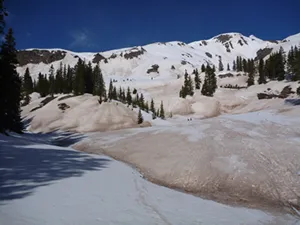Dark-colored dust that settles on snow in the Upper Colorado River Basin robs the Colorado River of about five percent of its water each year, according a new study coauthored by NSIDC researcher Jeffrey Deems.
Snow dusted with dark particles absorbs more of the sun's rays and melts faster than white snow, said coauthor Deems. Earlier snowmelt then lets vegetation that is normally snow-covered start growing earlier, so even more water is lost through evaporation and transpiration, he said. That leaves less water for the Colorado River, which supplies water to more than 25 million people in seven states and two countries. The quantity of lost water is nearly twice what the city of Las Vegas uses in a year, says study coauthor Brad Udall, director of the Western Water Assessment (WWA)—a joint program of CIRES and NOAA.
Heavy dust coatings on the snowpack are a relatively recent phenomenon. Since the mid-1800s, human activities such as livestock grazing and road building have disturbed the desert soil and broken up the soil crust that curbs wind erosion. Winds then whip up the desert dust—from northwest New Mexico, northeast Arizona, and southern Utah—and drop it on mountains downwind that form the river's headwaters, Deems said.
"Dust can have an impact even when it's too sparse to notice," said study leader Thomas Painter, an atmospheric scientist at the Jet Propulsion Laboratory in Pasadena, and NSIDC affiliate scientist. "But it can get to the point where it looks like cinnamon toast."
To evaluate how the dust impacts snowmelt, the team used a hydrology model to simulate snowmelt and river flows at Lees Ferry, Arizona for the "lower dust" conditions, prior to the disturbance of desert soils. They compared these data to dust levels and river flows observed between 2003 and 2008.
Snowmelt in the current dusty conditions occurred nearly three weeks earlier than in pre-settlement conditions, the results showed, and an average of 5 percent less water flowed into the river above Lees Ferry. "This is the first time anyone has attempted to quantify the impacts of dust on runoff," Deems said.
"This result suggests that if we can change our land management practices to reduce desert soil disturbance, then perhaps we can extend the snowmelt season," Deems said. "This might allow more runoff than is currently the norm." Such a runoff boost may help offset the river's projected runoff losses due to warming temperatures, and mitigate management tensions over the West's most over-committed resource, Udall said.
Dust has settled on snowy mountain ranges around the world. Although the impacts on annual runoff may differ, depending on the seasonal rainfall patterns in each region, the impacts of dust on snowmelt are indisputable. Painter said. "Clean your snow, it lasts longer—it is that simple."
The study is published in the September 20 issue of the Proceedings of the National Academy of Sciences (PNAS). Coauthors on the PNAS study include Jayne Belnap of the U.S. Geological Survey in Utah, Alan Hamlet of the University of Washington and Christopher Landry of the Center for Snow and Avalanche Studies in Colorado. Funding from the project came from the National Science Foundation, the National Aeronautics and Space Administration and the Western Water Assessment.
More Information
CIRES press release: https://cires.colorado.edu/news/press/2010/dustonsnow.html
Jeffrey Deems: https://nsidc.org/research/bios/deems.html
Media Contacts
Thomas H. Painter, Jet Propulsion Laboratory, Pasadena, CA:
Thomas.Painter@jpl.nasa.gov or +1 626.319.3111
NSIDC Press Office:
press@nsidc.org or +1 303.492.1497
